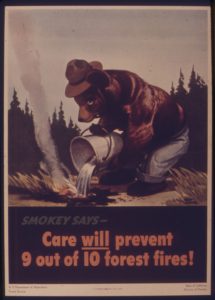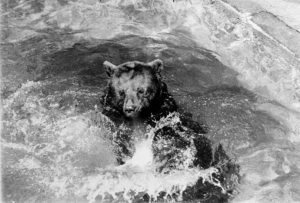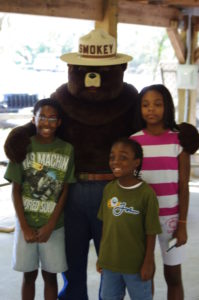Perhaps “born” isn’t quite the correct verb. Smokey “was conceived” on August 9, 1944, when the first poster bearing his imaged was commissioned. Since then, Smokey Bear has become one of America’s best known and best loved images, filling out the trio of Mickey Mouse and Santa Claus.
Smokey was, from the beginning, a patriotic bear. The impetus for Smokey came from worries during World War II. After Japan attacked Pearl Harbor, Japanese submarines and other vessels appeared along the country’s Pacific Coast and once successfully fired shells into a coastal oil field, starting a fire adjacent to a national forest. Forestry officials worried that enemy shelling of coastal forests could cause devastating fires. And with most fire-fighters and other men away on war duty, those fires might readily spread out of control.
In an effort to raise the awareness of forest fires as a national-defense issue, The US Forest Service, Association of State Foresters and the War Advertising Council formed the Cooperative Forest Fire Prevention program. The program began promoting forests as essential to winning the war—and preventing forest fires as a patriotic duty. Slogans included “Forest Fires Aid the Enemy” and “Our Carelessness, Their Secret Weapon.”
They soon hit on another idea that proved to be a winner. Walt Disney aired the film “Bambi” in 1942, including the blazing forest fire scene that scared us all as kids. Disney allowed the program to use Bambi’s image on a fire-prevention poster for one year. It proved so popular that the program knew it needed a permanent mascot for their cause. On August 9, 1944, the program agreed that a bear should be their symbol.

They commissioned artist Albert Staehle to draw the poster. Staehle, who lived from 1899 to 1974, was one of the best known advertising artists during the first half of the 20th Century. He was especially renowned for his animal subjects, including Elsie the Cow, Borden Dairy’s famous spokes-animal (remember the contented cows?). Staehle’s initial rendition of Smokey appeared on October 10, pouring a bucket of water on a campfire. The poster read, “Smokey says—Care will prevent 9 out of 10 forest fires!”
A star was born! Smokey’s image became so popular that the federal government had to pass a law that removed Smokey from the public domain and trademarked it for commercial purposes (royalties that still come in are used for wildfire prevention). Over the years, Smokey’s look evolved, from a bear cub to a realistic adult bear, complete with fearsome fangs and claws. US Forest Service artist Rudy Wendelin took over Smokey’s image, eventually molding him into the human-like character we know today, complete with human hands and dressed in jeans and hat. Being Smokey’s “caretaker” became Wendelin’s full-time job for the remainder of his career with the Forest Service and on into retirement.
The message evolved, too. In 1947, his slogan became, “Only you can prevent forest fires. In 2001, his slogan changed again, to “Only you can prevent wildfires.” The change emphasizes the danger of wild fires to human life and buildings.

It was inevitable, I suppose, that the imaginary Smokey would turn real one day. During a forest fire in New Mexico in 1950, fire fighters rescued a small black bear cub from the fire. The bear’s paws and rear legs were burned, but it recovered under care by the New Mexico Department of Game and Fish. The story of the rescued cub “went viral.” Soon, Smokey was transferred to the National Zoo in Washington, where the bear lived until its death in 1976. Smokey is buried at the Smokey Bear Historical Park in Capitan, New Mexico. No living specimen replaced the original.
But Smokey’s legacy certainly lives on. He is still so popular that he has his own zip code (20252), along with his own Facebook (300,000 friends), Twitter (24,000 followers), Instagram, YouTube and Flickr accounts.

One final point. There’s an old joke, “What is Smokey the Bear’s middle name?” The corny answer is “the.” Except it isn’t. Smokey doesn’t have a middle name. He is simply Smokey Bear, always has been and always will be. However, a song about him, written in 1952, stuck “the” in his name so the lyrics would match the song’s rhythm. Remember that for your next trivia contest.
References:
American Art Archives. Albert Staehle (1899-1974). Available at: https://www.americanartarchives.com/staehle.htm. Accessed June 11, 2018.
CBS News. 2014. Smokey Bear turns 70, and he’s burning up social media. CBS News, August 8, 2014. Available at: https://www.cbsnews.com/news/smokey-bear-turns-70-and-hes-burning-up-social-media/. Accessed June 11, 2018.
Pearson, Richard. 2000. Rudolph Wendelin Dies at Age 90. The Washington Post, September 3, 2000. Available at: https://www.washingtonpost.com/archive/local/2000/09/03/rudolph-wendelin-dies-at-age-90/676783da-263d-41e4-a920-9782c69b4337/?noredirect=on&utm_term=.16b43e68c384. Accessed June 11, 2018.
Smokeybear.com. About the Campaign. Available at: https://smokeybear.com/en/smokeys-history/about-the-campaign. Accessed June 11, 2018.
